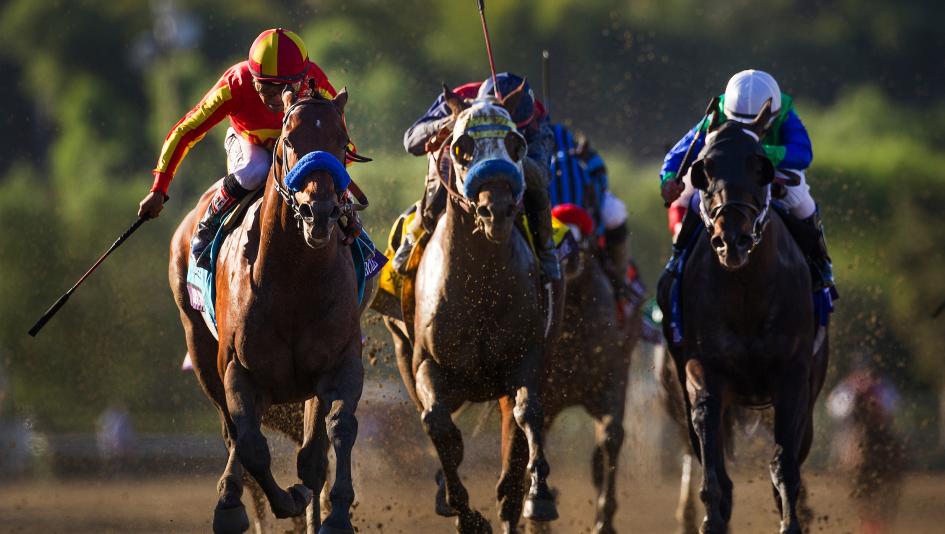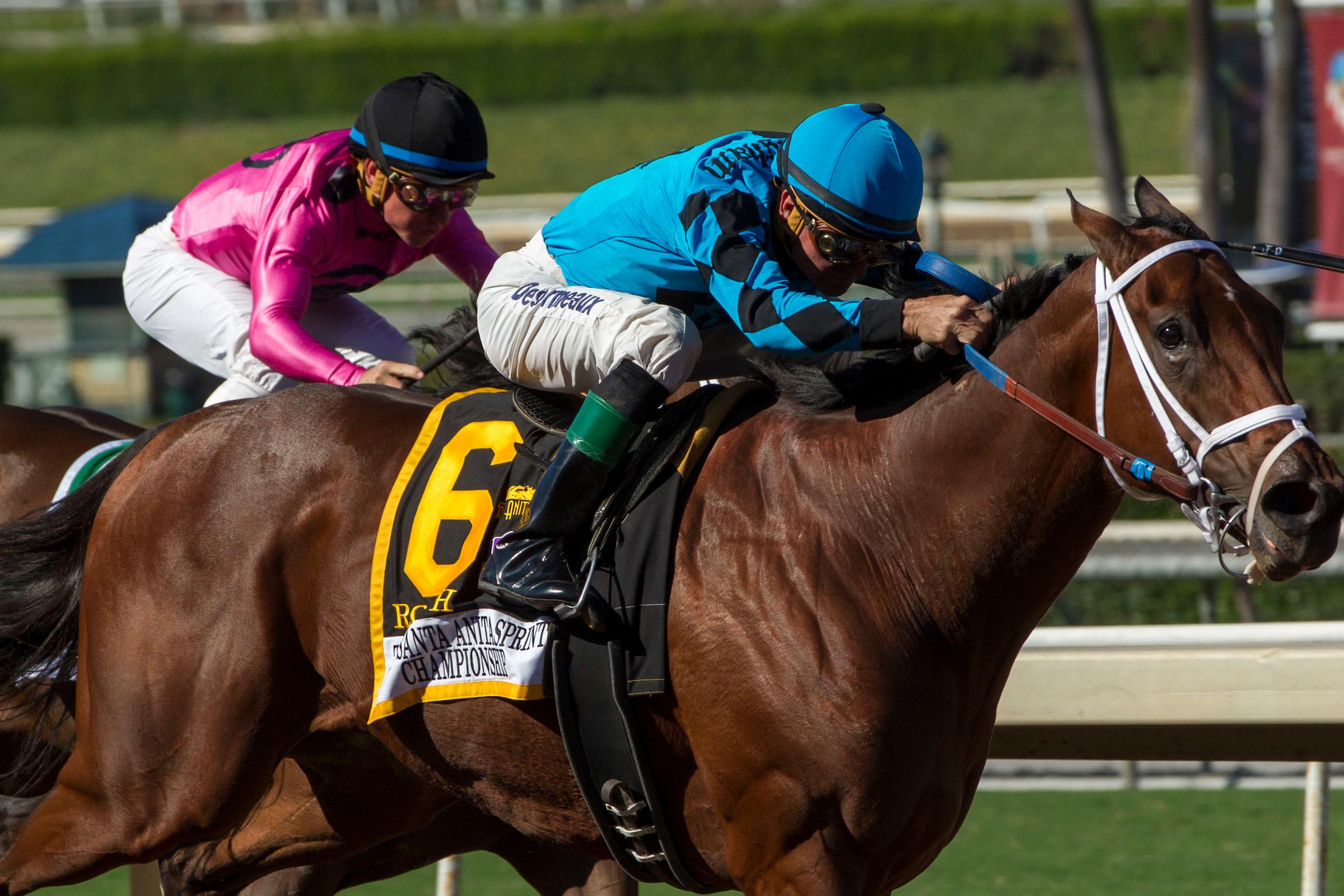The TwinSpires.com Breeders’ Cup Sprint is, in many ways, representative of U.S. racing. Speed rules, and dirt sprints are the most common races, meaning the sprint division frequently is as deep with talent as any other leading up to the Breeders’ Cup World Championships.
Unlike typical U.S. races, in which favorites win at about 37-38 percent of the time, over the last 20 years the sprint favorite is clicking at only 25 percent with five winning favorites. What would seem like the simplest race to handicap on the card actually is an interesting challenge. There are quite a few interesting nuggets that come out of the historical data for this three-quarter-mile race.
With that in mind, let’s take a deeper dive into the last 20 editions of the Sprint. First, I’ll take a closer look all 20 races to try to identify some historical trends that could provide a key angle or two to consider. Since this year’s Breeders’ Cup will be held at Del Mar near San Diego, I’ll next narrow the scope to go in depth on the editions of the Sprint held on dirt in Southern California over the last two decades. For this exercise, I removed the two synthetic races in 2008 and 2009 from the Southern California Breeders’ Cup Sprint data to really dig into a typical California dirt sprint. Lastly, we’ll take a closer this year’s contenders to try and identify a few runners that fit the profile of a Breeders’ Cup Sprint winner.
What are some of the key takeaways from the last 20 editions of the Breeders’ Cup Sprint?
- Recent form is the strongest indicator. Fourteen of 20 Breeders’ Cup Sprint winners won their final prep race and 19 of the 20 finished in the top three. Only Midnight Lute, who prepped for his repeat Sprint win in 2008 by finishing 10th in his first start in nine months, was outside of the top three in his final start.
- Drilling down further into recent form, looking at the pre-Breeders’ Cup starts from June through October (not counting the Sprint), the winners of this race combined to post 34 wins, 16 seconds and four thirds in 60 combined starts. That’s a remarkable 50 top-two finishes in the 60 prep races from June-October by future Breeders’ Cup Sprint winners! Upset winner Elmhurst 20 years ago accounted for two of the six total unplaced finishes.
- Eighteen of the 20 winners were graded stakes winners, including seven Grade 1 winners. The two others – Dancing in Silks in 2009 and Thor’s Echo in 2006 – were stakes winners.
- Don’t overlook talented 3-year-olds. Facing older horses in an elite Grade 1 race on Breeders’ Cup day is a significant challenge, but there have been seven 3-year-old winners of this race in the last 20 years. Improving 3-year-olds who find their niche sprinting can be very dangerous.
- As mentioned in the introduction, only five favorites have won the Sprint in the last 20 years and there have been seven winners at double-digit odds and five winners at 15-1 or higher, including Dancing in Silks at 25.30-1 in a four-horse photo finish on the synthetic surface at Santa Anita in 2009 and Cajun Beat at 22.80-1 in 2003. Cajun Beat was an improving 3-year-old who briefly tried his hand on the Kentucky Derby trail and really excelled when cutting back to sprints.
- Eleven of the 20 Sprint winners were horses whose preferred running style entering the race was either on the lead or battling for the lead. Some of them had to settle a little farther back than usual in the sprint to avoid a speed duel, but this is a race in which tactical speed is usually a necessary asset.
- Closers have won only three of 20 editions of the Sprint. Two of those were Midnight Lute, who was just a beast of a racehorse, and the other was 16.60-1 upset winner Elmhurst in 1997. Elmhurst capitalized on a blistering opening half-mile in :43.89 to rally from last of 14. He was winless in eight subsequent races.
- Three Sprint winners were first after the opening quarter-mile. That number increased to six after a half-mile and 10 winners were first in early stretch (roughly an eighth of a mile remaining). Nine of the other 10 were second or third, and only Elmhurst (fifth) was outside the top three in early stretch.
- The average winner was 2.20 lengths back after the opening quarter-mile, 1.58 lengths back after a half-mile, and less than a head behind the leader in early stretch. Median places the winner 1 ¼ lengths back at both the quarter- and half-mile point in the race and between a head and a nose in front in the stretch.
- The average margin of victory is 1.16 lengths with a median of 1.375 lengths over the last 20 Breeders’ Cup Sprints.
- The average Equibase Speed Figure for the last 20 editions of the Sprint was 118.1 with a median of 118.5.
- Drefong will be attempting to repeat in the Sprint, a daunting task give only one of seven repeat bids in the last 20 years (Midnight Lute in 2008) was successful.
How does that change after narrowing the focus to Breeders’ Cup Sprint races held on dirt (2016, 2014, 2013, 2012, 2003, 1997; the two synthetic races in 2008 and 2009 were excluded) in Southern California?
- Recent form again holds significance as five of the six winners won their final prep race and the other, Trinniberg in 2012, finished second by a half-length.
- Looking at the pre-Breeders’ Cup starts from June through October (not counting the Sprint), the six winners posted nine wins and six seconds in 18 starts.
- All six winners were graded stakes winners before the Breeders’ Cup.
- Three of the six winners were 3-year-olds.
- Only one favorite, Secret Circle at 5-2 in 2013, won in the six editions of the Breeders’ Cup held in Southern California on dirt. Four of the six winners prevailed at odds of 13.70-1 or higher: Work All Week, 19.10-1 in 2014; Trinniberg, 13.70-1 in 2012; Cajun Beat, 22.80-1 in 2003; and Elmhurst, 16.60-1 odds in 1997.
- The average odds for the winner in the six editions of the Breeders’ Cup held in Southern California on dirt is 13.10-1 with a median of 15.15-1.
- Four of the six winners were horses who preferred to set the pace or contest the pace.
- Four of the six were third or better after the first quarter-mile and four were second or better after a half-mile. Average distance behind the leader for the first quarter was 2.1 lengths, which is somewhat skewed by deep closer Elmhurst, with the median of a half-length probably a better indicator. The median distance back after a half-mile was a neck.
- Besides deep closer Elmhurst, all five were in front in early stretch (eighth pole), with an average of between a neck and half-length in front and a median of three-quarters of a length.
- The average Equibase Speed Figure for these six editions of the Sprint on dirt in Southern California was 117.3 with a median of 117.
- Horses bidding for a repeat Breeders’ Cup Sprint win on the dirt in Southern California are 0-for-3.
Which of this year’s contenders fit the typical profile of a Breeders’ Cup Sprint winner?
I think the big question entering this year’s edition of the TwinSpires.com Breeders’ Cup Sprint is: can anyone beat last year’s winner and champion sprinter Drefong? He’s the controlling speed in the race and enters as the probable heavy favorite off an impressive four-length victory in the Grade 1 Forego Stakes in August at Saratoga. But I think he could be vulnerable.
If you’ve read this far, you see that repeating in this race is no easy task. Drefong has the right trainer for the job in Bob Baffert, who prepared Midnight Lute perfectly, but I see a trio of contenders who pose a serious threat.
Let’s start with Roy H, who most likely will be my pick to win. He’s won two of three since June with the lone blemish a runner-up finish by 1 ½ lengths at Del Mar in the Grade 1 Bing Crosby Stakes. That shape of that race changed almost immediately when Drefong unseated jockey Mike Smith, and the riderless champion sprinter forced Roy H extremely wide entering the stretch, allowing winner Ransom the Moon to slip through the inside and take command. Other than that, Roy H has been pretty close to perfect since switching from turf to dirt in May, winning three of four races by a combined margin of 10 ¾ lengths, most recently winning the Grade 1 Santa Anita Sprint Championship Stakes. A Grade 1 winner in career-best form with the tactical speed to rate just off the pace, Roy H owns the two highest Equibase Speed Figures earned in sprint stakes on the main track in 2017.
Imperial Hint also looks very dangerous. We ran a nice feature in September on his connections, and this is a 4-year-old who has never been better. He’s won five straight races with Equibase Speed Figures of 120, 121, and 124 for his three most recent wins. He won the Grade 3 Smile Sprint Stakes by 4 ¾ lengths in July and the Donald Levine Memorial Stakes by 6 ¾ lengths in an eye-catching 1:07.55 for three-quarters of a mile, just four-hundredths of a second off the Parx Racing track record for the distance. He also has tremendous natural speed and should be very close to the pace.
I’ve never before been on the Takaful bandwagon, but I have to admit he’s very intriguing in the Sprint as a 3-year-old who has excelled since returning to sprints after a pair of distant, unplaced finishes on the Triple Crown trail. Takaful has two wins and a second in three sprint starts since July, including a clear win over older horses in the Grade 1 Vosburgh Stakes at Belmont Park on Sept. 30. He really seems at his best at three-quarters of a mile, posting a new career-best 122 Equibase Speed Figure at that distance in the Vosburgh, and he has the tactical speed to dart straight to the front or settle in just behind the pace.


